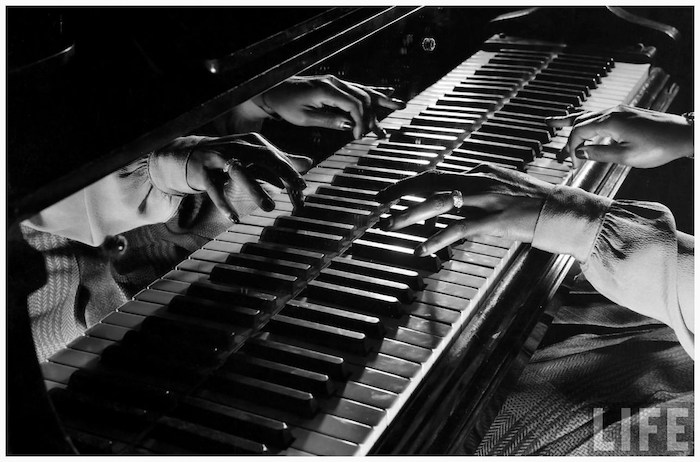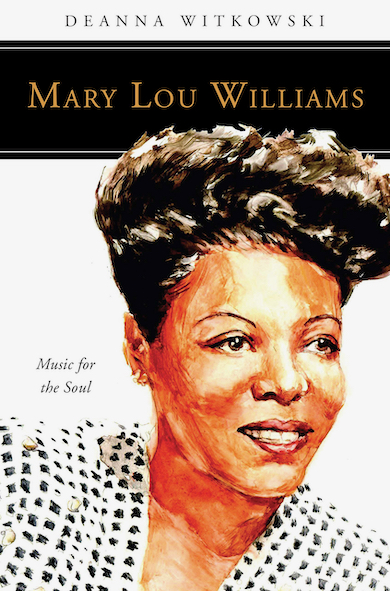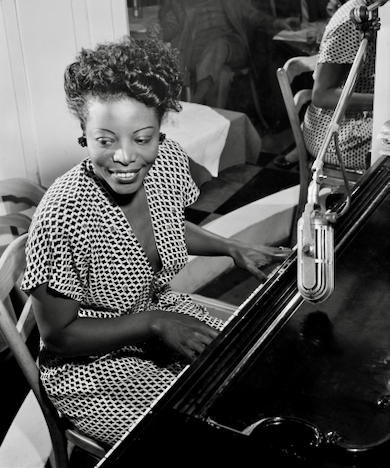
This Gjon Mili photograph of Mary Lou Williams’ hands was taken during the early 1940s jazz sessions Mili hosted for LIFE, but the photograph was not included in the 1943 special issue. You can learn more about Mili via Wikipedia. And, you can see an online version of his famous 1943 illustrated story for LIFE here, based on what has been described as “the single greatest jazz session ever held in New York City.”
.
By DAVID CRUMM
Editor of Read The Spirit magazine

Click the cover to visit the book’s Amazon page. Another option is to purchase a copy of the book from Deanna’s own online store. Deanna says she will sign copies bought from her store.
Deanna Witkowski’s new album, Force of Nature, opens with a five-minute tour de force celebrating the vibrant legacy of jazz pioneer Mary Lou Williams. That spirited selection, called Gjon Mili Jam Session, comes from music Williams played in the early 1940s gatherings of jazz greats sponsored by LIFE magazine in New York City that now are known simply as the Gjon Mili Jazz Sessions.
“Anyone who loves jazz could only wish to have been alive and sitting somewhere in that room on the night Mili shot those photographs for LIFE,” says Deanna Witkowski, who has been promoting awareness of her spiritual mentor for many years, culminating in her new book, Mary Lou Williams—Music for the Soul, and her new album.
In an interview about her lively spiritual relationship with Williams, who died in 1981 at age 71, Deanna highlighted a passage from the opening of her new book that sums up the connection: Over the years, “I began to realize that I was literally walking in Mary’s footsteps. As a musician who presents jazz in churches of all different denominations, I often picture Mary seated at the piano in St. Patrick’s Cathedral on Fifth Avenue, playing her joyous Mary Lou’s Mass with her trio in front of 3,000 people as five priests process to the altar. Mary gives me courage. Sometimes I speak with her before I play, knowing that in a very real sense, she has been here before me.”
“You speak to her like a saint?” I asked Deanna.
“I would say that sometimes I speak with her when I need inspiration, because she knew so much about the challenges musicians face, and sometimes before I begin playing on stage, I send a quick prayer to Mary—to Mary Lou Williams,” she said.

Click the cover to visit the album’s Amazon page. Another option is to purchase a copy of the CD from Deanna’s own online store. CARE TO LEARN MORE ABOUT THIS CD before ordering your own copy? Here are two links to short CD-preview videos. Here’s a 24-second version. And here’s a 1-minute version.
Of course, I wanted to know more. I said, “As you describe in your book, Williams had a vast career from the 1920s through the 1970s, marked by a huge number of challenges from racism to sexism to her eventual decision to selflessly give back to the musical community on a daily basis. In her apartment and across her neighborhood, she personally cared for a number of jazz legends when they were facing hard times,” I said. “In talking about your own daily relationship with Mary now, tell us more about the challenges you face that Mary also faced.”
“Of course, I don’t face everything she faced,” Deanna said. “What I’m talking about are the day-to-day frustrations and the need to find the energy that it takes to keep doing certain kinds of work as a jazz musician and composer—like getting people on board with new projects. That may sound like mundane business to your readers, but this life is not playing the piano. There’s so much other daily work involved in booking gigs, arranging for performances, setting up future projects. Now, anyone who reads my book about Williams’ life will learn that she was both one of our greatest jazz musicians—and they’ll also learn that her faith led her to become a great humanitarian as well. For me, how I relate to Mary on a daily basis has to do with the creative energy it takes to get this music out to people. That takes so much work! And somehow Mary kept finding that energy. She kept going.”
As Deanna explains on her website, the releases of the book and album “cap a 20-year deep dive into the ground-breaking impact of Williams’ life and music.” In the process, Deanna has become a leading authority on Williams. What makes her new biography-and-album so compelling, compared with the two other earlier biographies of Williams, is that Deanna not only researched Williams’ life. She also continues to live, breathe, arrange and perform Mary Lou Williams, giving Deanna an unparalleled empathetic connection with Williams. Deanna has presented at the Kennedy Center, Duke University, Fordham University—and has performed Williams’ compositions as a featured guest with the Pittsburgh Symphony Orchestra.
Please note: Deanna also is thankful for Williams’ earlier biographers, who wrote for university-based publishing houses; she recommends their significantly longer books if you find yourself fascinated with Williams and want to learn much more about her early life—so, Deanna asked that we include links to their books at the end of this story.
Deanna also helped to select some video clips, below, that will give you a feel for Williams’ music and her legacy.
But first: Why is Williams such a giant among jazz musicians?
Well, the first answer is: Get a copy of Deanna’s book and read it.
But, one way to quickly shore up Deanna’s enormous respect for Mary Lou Williams is to turn to the words of legendary jazz journalist John S. Wilson, music critic for The New York Times for four decades. When Mary died in 1981, Wilson honored her with a lengthy profile of her career. In part, he wrote:
Mary Lou Williams, pianist, arranger and composer who was the first woman to be ranked with the greatest of jazz musicians, died of cancer at her home in Durham, N.C. She was 71 years old.
This is one of many photographs taken of Mary Lou Williams by the famous photographer William Gottlieb in sessions between the late 1930s and late 1940s and was visual source material for the cover illustration on Deanna’s new biography. You can see more of Gottlieb’s photographs via the Library of Congress website. Or, you can read more about his career on Wikipedia.
Miss Williams was an important contributor to every aspect of jazz that developed during a career that began in the late 1920’s and lasted for more than half a century. She was involved in the vitalizing Kansas City jazz world at the end of the 20’s, when she was playing piano and writing for Andy Kirk’s Twelve Clouds of Joy.
She was an essential element of the Swing Era when she wrote ”Roll ‘Em” and ”Camel Hop” for Benny Goodman, ”What’s Your Story, Morning Glory” for Jimmie Lunceford and ”Trumpets No End” for Duke Ellington. In the be-bop years in the 40’s, she wrote a Dizzy Gillespie hit, ”In the Land of Oo-Bla-Dee,” and after she became a devoted religious convert in the late 50’s, she wrote a number of religious works, including a mass that was performed at St. Patrick’s Cathedral.
Miss Williams’ apartment in Sugar Hill Harlem was a place where musicians of all styles and statures flocked. ”I’d leave the door open for them if I was out,” she said. ”Tadd Dameron would come to write when he was out of inspiration, and Thelonious Monk did several of his pieces there. Bud Powell’s brother, Richie, who also played piano, learned how to improvise at my house. And everybody came or called for advice. Charlie Parker would ask what did I think about him putting a group with strings together? Or Miles Davis would ask about expanding his group with a tuba.”
In our interview, Deanna verified that Wilson had effectively hit many of the highlights of Williams’ career.
“But there’s a lot in that piece by Wilson that only people who follow jazz would understand. When he quoted Mary as saying that Charlie Parker consulted her on working with strings and Miles Davis talked to her about his idea of forming a tuba band—those now are famous innovations in jazz history. What Mary was explaining to the interviewer is that she really was right at the heart of what was happening in jazz.”
What also is clear in Wilson’s tribute is the reason that Deanna’s new book is unique in the field of her biographies. Wilson all but buries half a sentence about Mary Lou Williams’ sacred music in a longer paragraph about her popular jazz. In Deanna’s book, Williams’ conversion to Catholicism and her later music are essential parts of her life. In fact, as you will discover in Deanna’s book, Mary Lou Williams continued to establish historic landmarks in jazz-style sacred music until her untimely death.
Videos of Deanna and Mary Lou
Let’s start with one of the official video-previews for Force of Nature.
Then, here’s a 3-minute introductory video that Deanna posted to her YouTube channel. The clip begins with a final short segment of the Gjon Mili Jam Session, which is the first track on her new CD.
This 7-minute video is a homemade clip Deanna streamed in 2021, when the book first was released. The CD’s release followed many months later. In this first video, below, Deanna reads a bit from the book.
After that first video, Deanna made a second video in which she plays from Mary Lou Williams’ version of The Lord’s Prayer.
.
Care to learn more?
For all of Deanna’s videos, visit the Deanna Witkowski YouTube channel. (And note to readers: Deanna also has made lots of videos about the challenges of adapting jazz for sacred settings, including examples of her own compositions and arrangements. Especially if you are interested in this kind of music, there are a whole lot of terrific clips to share with friends in her YouTube Channel.)
There also are various videos of Mary Lou Williams’ performances floating around the internet. Many are of poor quality. Deanna says the best introductory documentary she has found is Music on My Mind, a one-hour documentary released in 1989 that currently is streaming on Vimeo.
For a deeper dive into Mary Lou Williams’ life, Deanna also recommends two earlier and more in-depth biographies. Deanna’s new biography is 168 pages.
- Linda Dahl’s 2001 biography, Morning Glory—A Biography of Mary Lou Williams, is 465 pages from the University of California Press.
- Tammy Kernodle’s 2004 biography, Soul on Soul—The Life and Music of Mary Lou Williams, is 375 pages from the University of Illinois Press. 365 pages from the University of Illinois Press.
.
.

